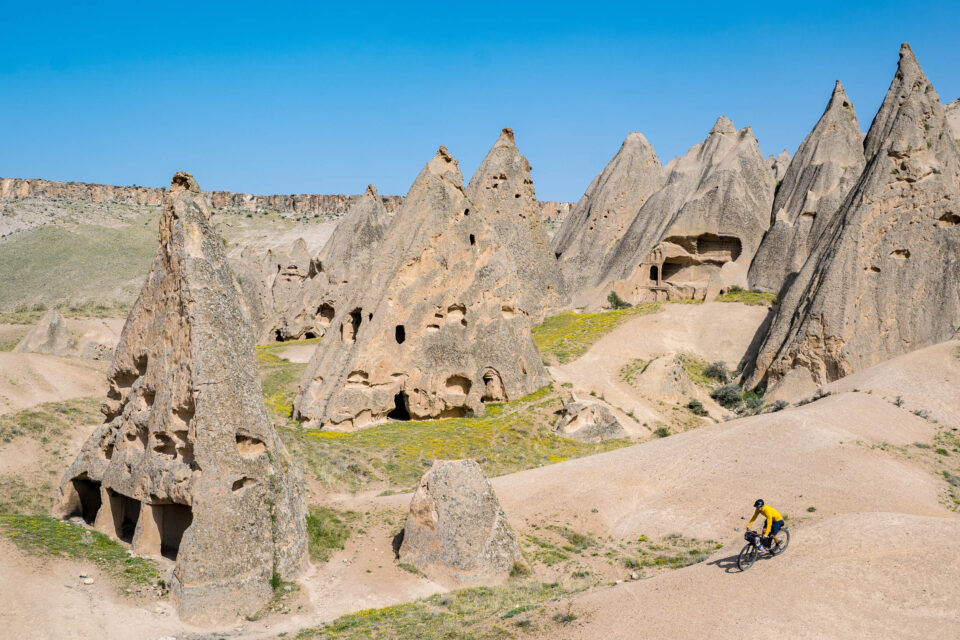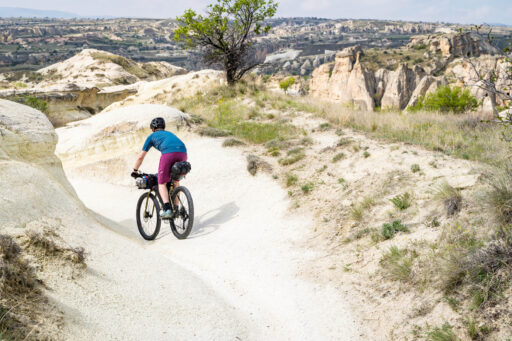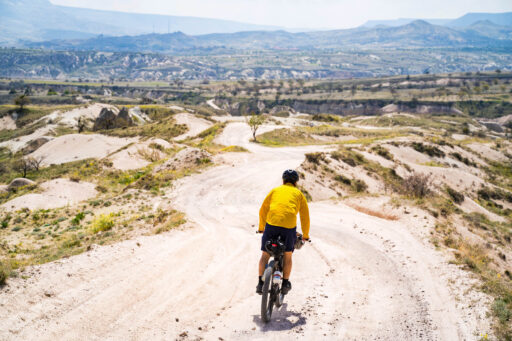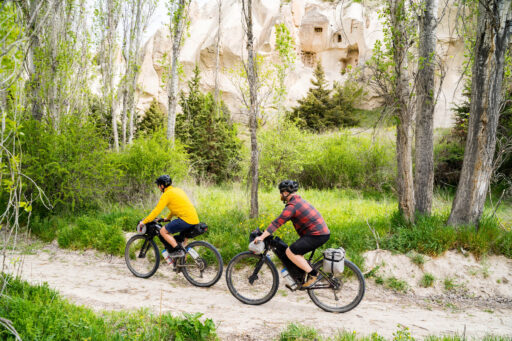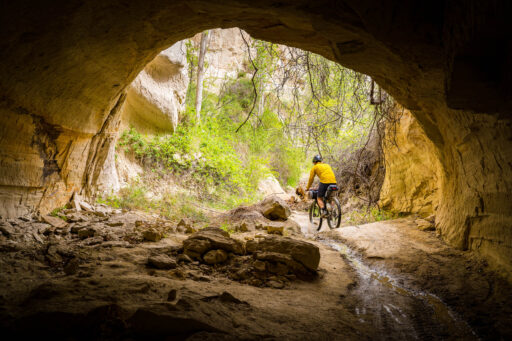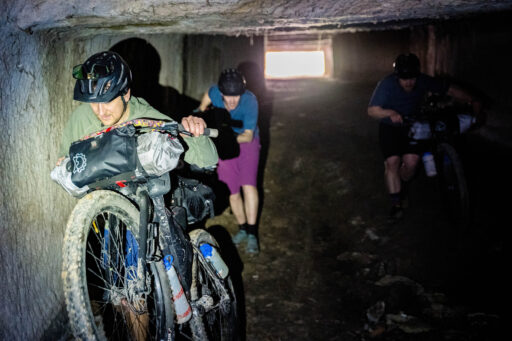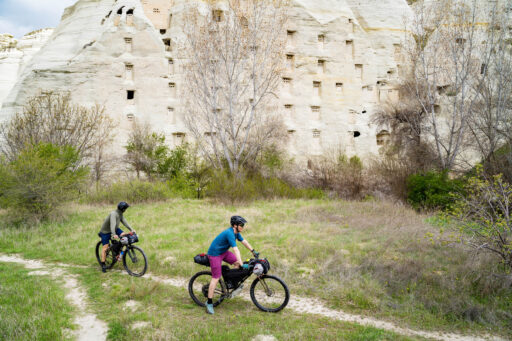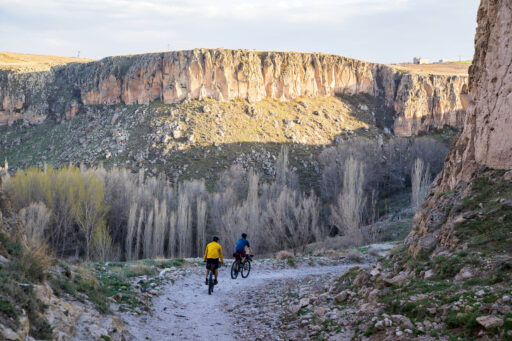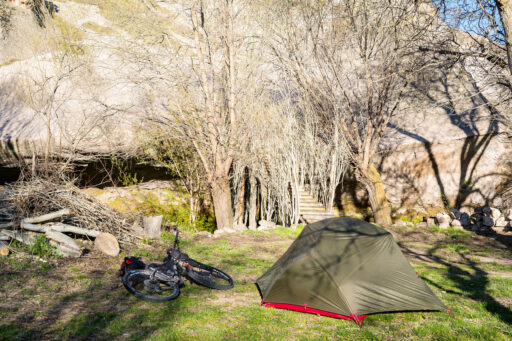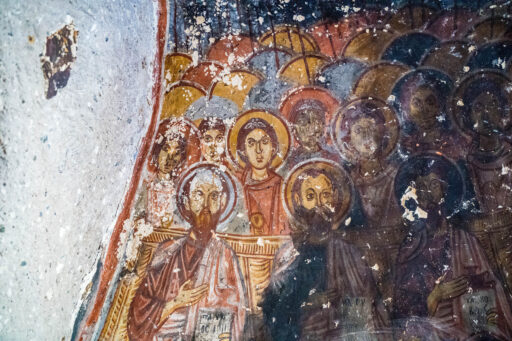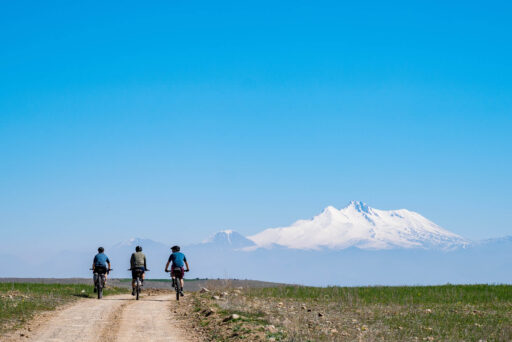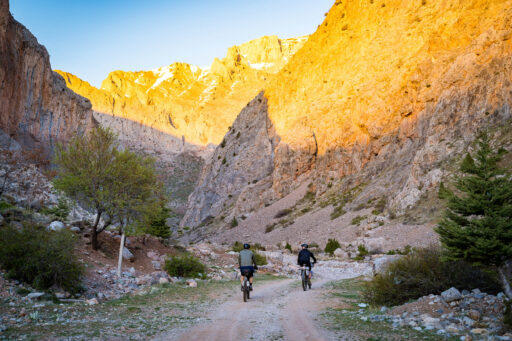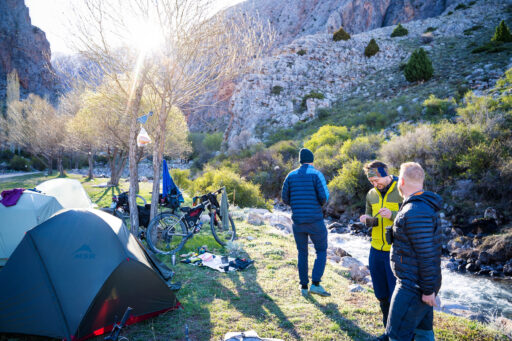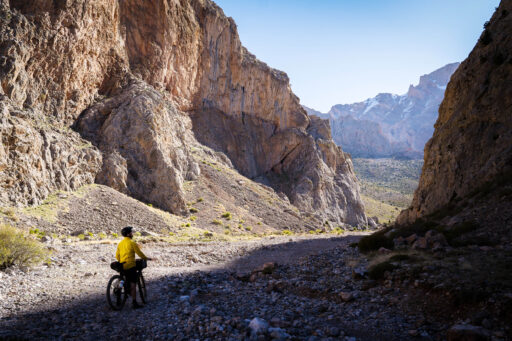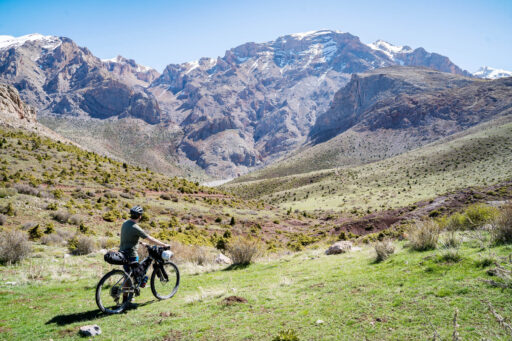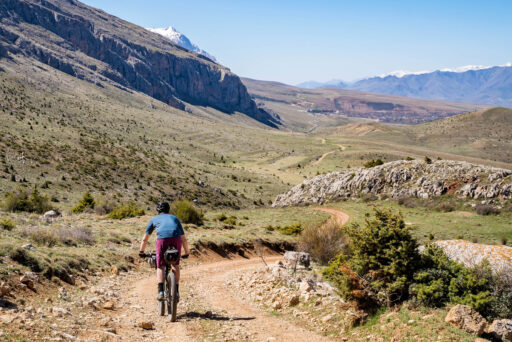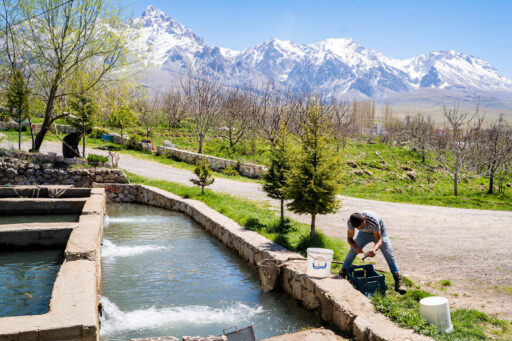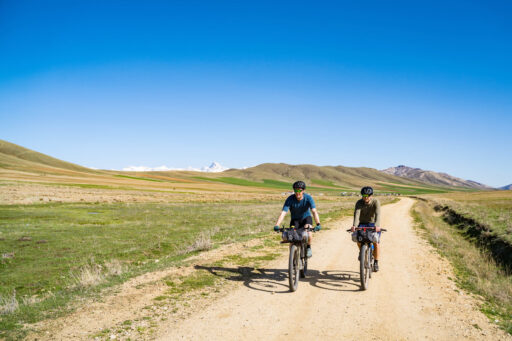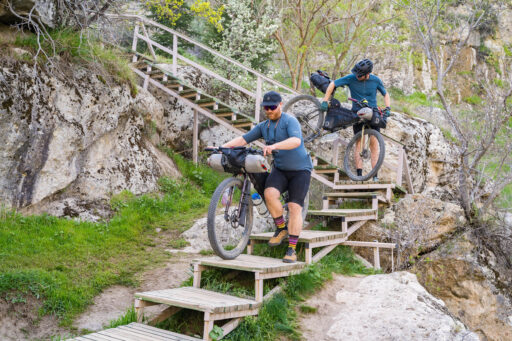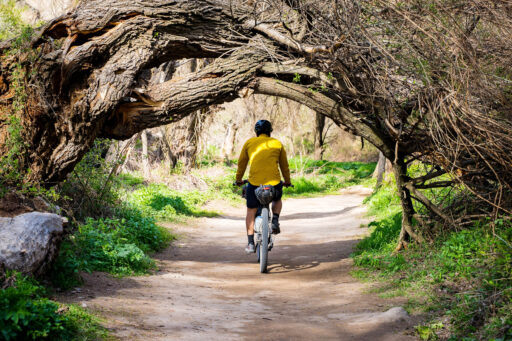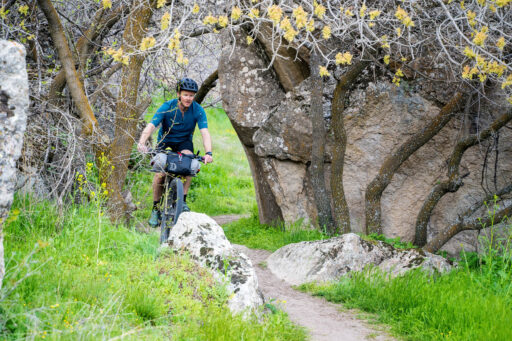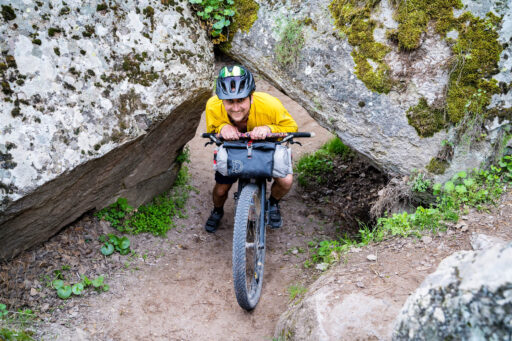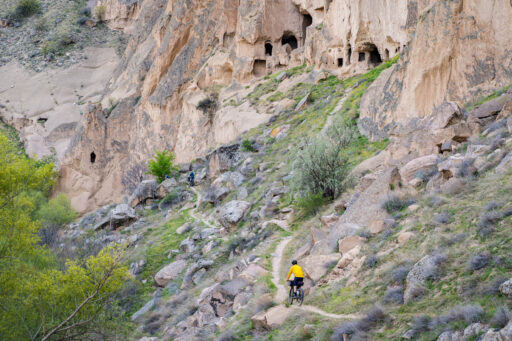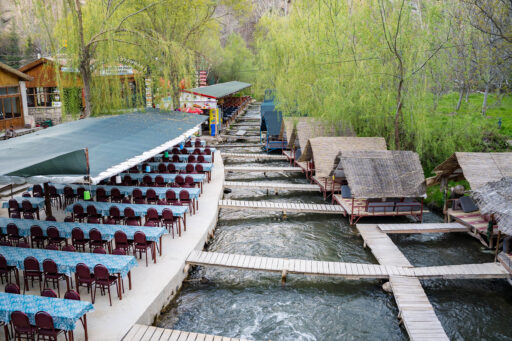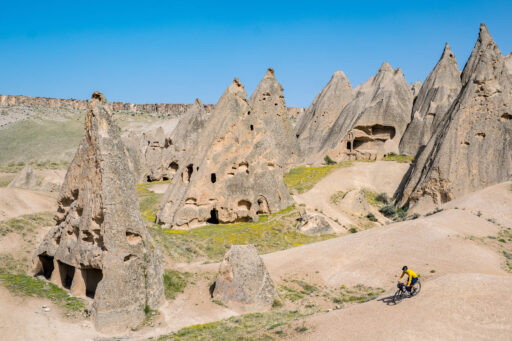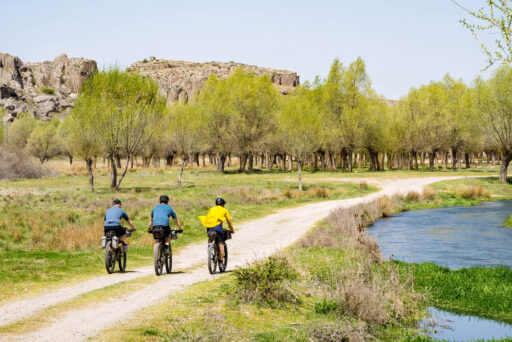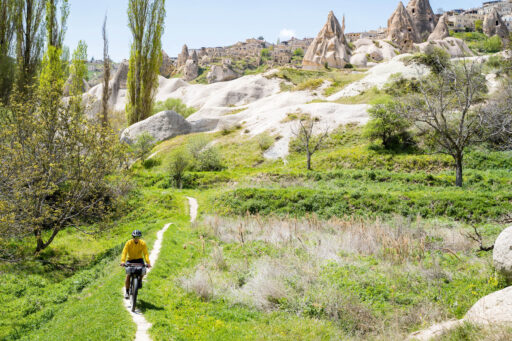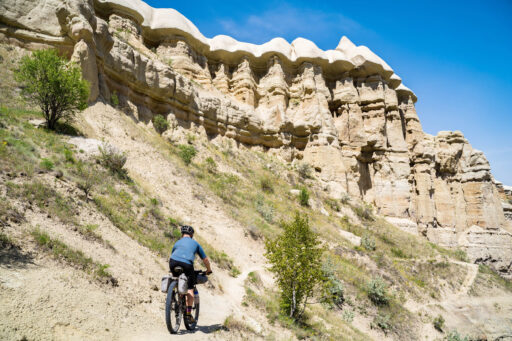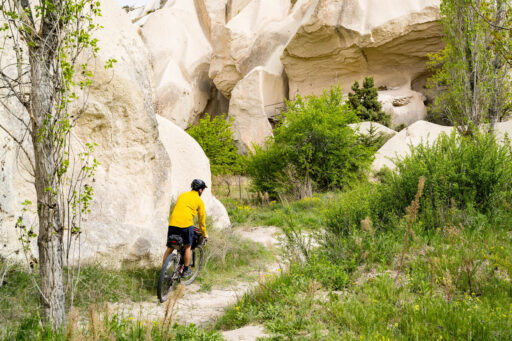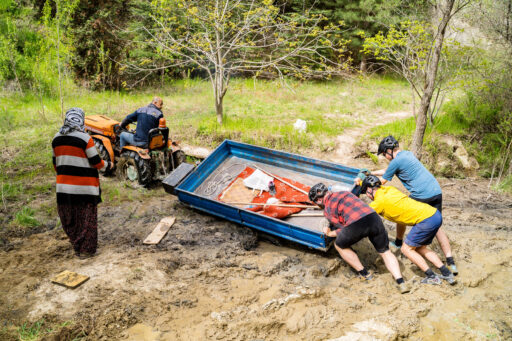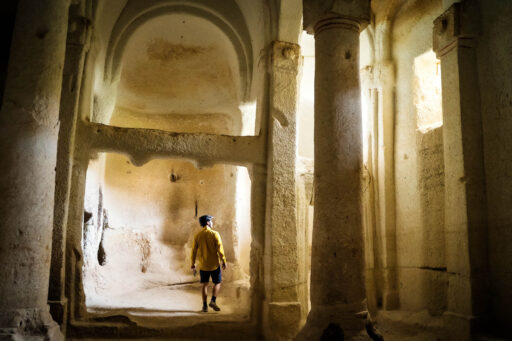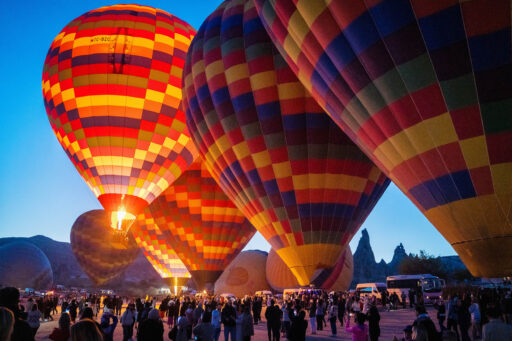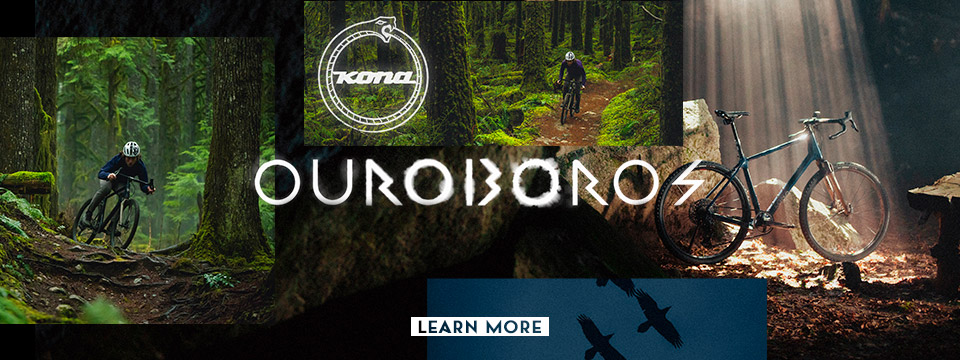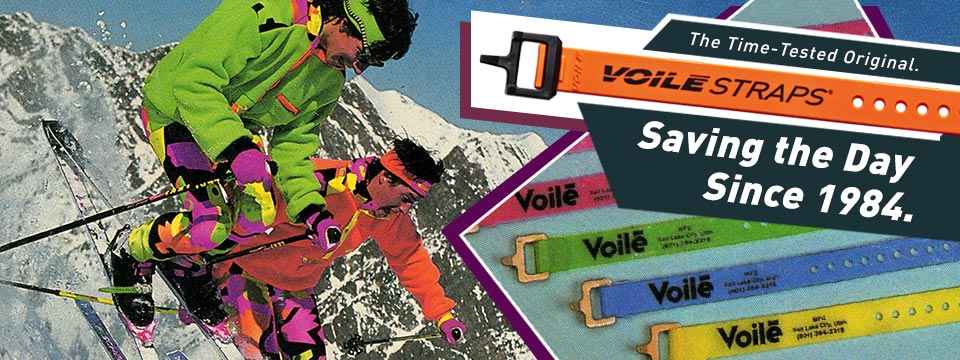Cappadocia Delight
Distance
249 Mi.
(401 KM)Days
7
% Unpaved
52%
% Singletrack
15%
% Rideable (time)
95%
Total Ascent
20,148'
(6,141 M)High Point
6,964'
(2,123 M)Difficulty (1-10)
7?
- 5Climbing Scale Moderate81 FT/MI (15 M/KM)
- 7Technical Difficulty Difficult
- 5Physical Demand Moderate
- 5Resupply & Logistics Moderate
Contributed By

Michael O'Dwyer
Bikepacking Sweden
Türkiye, as it’s officially known today, is renowned as one of the best bikepacking countries in the world. With jaw-dropping scenery, ancient history, and some of the friendliest locals you’ll ever meet, it’s no wonder. This tour far surpasses all your expectations of what the country has to offer.
We’ve all seen the images of colorful hot air balloons floating over mesmerizing sandstone towers. That’s Cappadocia, where the route begins. From there, it traverses rolling steppe and plateaus to link over to the other major tourist stop of the region, the Ihlara Canyon.
Türkiye is a modern 21st century country where 4G phone coverage is the norm and many of the roads are smooth and well maintained. But this tour also takes you to some of the less visited parts of the country. In many of the villages, you shouldn’t expect restaurants or phone shops, but do expect locals offering of Turkish chai and a street dogs eager for a belly rub. The more popular tourist destinations are another world altogether. Villages that were once for backpackers and hostels now feature boutique hotels and ballooning safaris. The contrasts are startling, but that’s part of what makes Türkiye such an interesting country.
Route Difficulty
The Cappadocia Delight can be divided up into two sections: the plateaus and the canyons. Except for a small number of sandy sections, the plateaus, which make up 90% of the tour, can be considered as very straightforward riding. The gravel roads are tame, with the majority of the climbing on asphalt or reasonably graded terrain. The second section takes you through the canyons, and this is a different riding experience. These singletrack sections are very manageable, but with some exceptional notes. In the Ihlara Valley, you will have to lift your bike over obstacles, squeeze through many rock passages, and carry it down numerous staircases. In Cappadocia, the riding is much easier, but there is a tough hike-a-bike in and out of the canyons. For these reasons, the overall route should be considered a grade 5, rising to 7 if you include the singletrack canyon sections.
Route Development
As always, when designing a route, an anchor point or reason to go is always the start. For this tour, the main Cappadocia region with its impressive geological features and historical buildings and caves were the attraction. When researching the greater region, once I realized the proximity of Ihlara and the Aladaglar National Park, the route basically designed itself. I thought the linking sections over the plateaus would be fairly uninteresting, but these rolling steppes turned out to be some of the most scenic parts of the tour and were just as interesting as the three main attractions.
A big thank you goes out to Revelate Designs, MSR, and Rab Equipment for sponsoring this trip. Also to my ever-reliable models/co-riders, Björn, Olle, and Paul, who regularly spare the general public from having to see my ugly mug. Thank you all.
Submit Route Alert
As the leading creator and publisher of bikepacking routes, BIKEPACKING.com endeavors to maintain, improve, and advocate for our growing network of bikepacking routes all over the world. As such, our editorial team, route creators, and Route Stewards serve as mediators for route improvements and opportunities for connectivity, conservation, and community growth around these routes. To facilitate these efforts, we rely on our Bikepacking Collective and the greater bikepacking community to call attention to critical issues and opportunities that are discovered while riding these routes. If you have a vital issue or opportunity regarding this route that pertains to one of the subjects below, please let us know:
Highlights
Must Know
Camping
Food/H2O
Trail Notes
- Experiencing the geological wonders of the Cappadocia Region. Rolling steppe-like plateaus give wonderful views over the towering volcanoes of Erciyes and Hasandaği and the dominating mountain range of Aladaglar National Park, contrasting with the deep canyon of Ihlara and the sprawling sandstone towers of Cappadocia. Both landscapes are spectacular in their own right.
- Exploring the deep canyon and fascinating caves of Ihlara. Spend an hour or days in the caves and think in disbelief that people still lived in them up until the 1960s.
- Peering into the Aladaglar National Park as you skim the outskirts of this 55,000-hectare reserve. Passing through the Maden Gorge gives you a real feeling of the size of these mountains, even if just for a few kilometers.
- Living underground in one of the ancient cities.Spend hours wandering the passages of the many underground cities of the region. If you have the time, detour to the center of the loop to check out Derinkuyu and Kaymakli Underground Cities.
- Drinking endless cups of chai with the locals. Expect to be offered chai again and again in the more remote parts of this tour.
- Spotting the local wildlife. We saw foxes, turtles, terrapins, wild mountain goats, and countless eagles and birds of prey.
- Sunrise hot air ballooning Cappadocia. Whether you are in the balloon or watching from the ground, this is an unforgettable experience. Arrange to start this tour at one of the many launch sites to get your adrenaline running. Then, either fly off into the sunrise or race around to watch the balloons fly out of the sandstone canyons.
- The best times to visit are between mid-April and late May and from mid-September until early November. Since the region is over 1,000 meters above sea level and has many mountains above 2,000 meters, it gets snow for several months over the winter. The summer months are hot.
- Some English is spoken in large towns, but in the more remote sections, expect to use Google translate or good old sign language.
- The local currency is Turkish Lira with a simple exchange rate of dividing by 3 to get an approximate US Dollar amount. In the larger, more touristy towns, you can use bank cards, but you will pay a service charge each time you use your card. Cash is king in these parts, with ATMs in the tourist villages around Cappadocia and the larger towns.
- This route could be ridden in five days or faster, but it’s recommended to allow six or seven to take your time visiting each of the historical centers.
- Getting to Cappadocia from Europe requires a long day of travel; folks will usually fly into Istanbul and then take a second flight to the city of Kayseri before 1.5-hour car/bus transfer to Cappadocia. For us, this transfer was $30 each to Ürgüp, where we were based. We arranged this through the hotel we stayed in on our first night. Ürgüp is the most reasonably priced town in Cappadocia, as it’s both a tourist destination and a living Turkish town.
- With the volatility in the Turkish economy and currency, the more organized hotels and taxi services will quote you prices in USD or Euros.
- Historically speaking, the Cappadocia region was a much larger area stretching to the Black Sea in the north. But today, when talking about Cappadocia, it means the villages of Göreme, Ürgüp, Ortahisar, and Mustafapaşa. Göreme, the largest of these villages, is the tourist and ballooning hub of the region.
Danger and Annoyances
- From our experience, central Türkiye is an incredibly safe region; we never once felt threatened or unsafe. You are more likely to be smothered with friendship and gifts than anything else. In the Cappadocia region, we met several women cycling and hiking solo, and they seemed perfectly happy to be there alone.
- Shepherds, sheep, donkeys, and dogs are a common sight in Türkiye but nothing to worry about. Here, the shepherds have more energy than the dogs, making touring in this part of Türkiye a pleasure to ride in.
- There are three types of dogs in Cappadocia. Wild dogs, of which there were many, were the friendliest. They love to be petted and given food. They were only ever aggressive if they had puppies nearby. Shepherd dogs were well controlled by their owners. Signal to the shepherds as you approach, and you will not have a problem. Guard dogs were the most noisy. Many were chained up but those that weren’t would stay close to their property and bark loudly. For all of these dogs, a loud shout and violent waving of your arms would usually solve the situation if one occurred.
- On the negative side, the touristy villages around Cappadocia and Ihlara are extremely overpriced compared to the rest of the villages on this tour. With no price lists in the more remote restaurants, you will not know the cost of your meal until the bill arrives. Expect to pay a relative premium.
- Litter around this part of Türkiye is a problem. Many of the scenic locations were spoiled by discarded glass bottles and plastic bags. The irony is that Turks are (rightfully) extremely proud of their nation and culture. We saw evidence of local government making steps in the right direction by providing bins in beautiful spots.
Ballooning in Cappadocia
By far, the biggest reason tourists visit Cappadocia is to go ballooning. You are usually picked up from your hotel at 4:30 a.m. and are back by 7 a.m. The flying time is about one to two hours. We heard of prices ranging from €200 to €500 for the experience, which can only go ahead when the wind conditions are right. Most ballooning tourists come for three days to maximize their flying chances. A different way to do it is to wild camp at one of the viewpoints and hope that the winds blow the balloons over you. Or, like we did, cheat! We hired a local taxi to take us to the rather exciting takeoff point, and once the balloons were airborne, they quickly drove us to the best viewpoint to watch the majority of balloons fly over us. We paid €50 for the four of us. Definitely worth the experience.
Why the Greek architecture in Cappadocia?
Greek culture and language arrived in the greater Cappadocia region during the time of Alexander the Great, and Christianity gained a foothold in the first century AD. Cappadocian Greeks had some of the first Christian monasteries, which played an important role in early Christianity. With the founding and advancing of Islam, the region became an important military frontier of what was then the Byzantine Empire in the Arab-Byzantine wars from the 7th until the 10th century. The locals dug into the soft volcanic rock to create fortifications and underground cities, which were used to hide out from raiding Arabs and Turks and even from the Mongolian invaders of the 15th century. These cave systems remained used until the Greek-Turkish population swap of 1923.
From the 11th century on, the Turkish language, culture, and Islamic religion became more and more dominant until the early 20th century when the Cappadocian Greeks were estimated to be less than 20% of the greater region’s population. In the more remote villages, such as the Ihlara valley and the villages around present-day Cappadocia, Greek language and tradition remained virtually untouched. With the fall of the Ottoman Empire and the foundation of modern-day Türkiye, there was an arrangement made between the Greek and Turkish governments to have a population swap (the Treaty of Lausanne). And so, after over 2,000 years of Greek presence in central Türkiye, Cappadocian Greeks were forcibly removed. But they left hundreds of Greek Orthodox Churches, architectural influences, and important frescoes and paintings, many of which can still be seen today.
The Cappadocia Canyons
When scouting this route, we rode several of the main canyons in Cappadocia to figure out which were most rideable. Our conclusions were as follows: most canyons had difficult entry points at the upper end of the system. Most had badly rutted valley floors and multiple sections of lifting, carrying, or lowering your bike off of ledges. The canyons we’ve included in the route description were, by far, the most rideable. One that didn’t make it into the route was Güvercinlik Vadisi, aka Pigeon Valley. This spectacular valley is easiest to enter just to the north of Uçhisar at about the halfway point of the system. South of this point is not advised. The rock structures were fantastic, but there was a challenging entry that you needed to be sure-footed and adventurous to complete. If this is the type of adventure you are looking for, then it’s a must-do and can be taken instead of the gravel road from Uçhisar to Göreme.
- Wild camping is accepted throughout the region.
- We never had a problem, and on the occasions when we asked to camp in a location, even in the garden of a restaurant, the answer was always yes.
- Hotels in Cappadocia range from $20 each a night to over $100. For the overall tour, I would recommend camping. There weren’t many hotels or lodging options outside the main Cappadocia region as nearly all tourists only want to stay in the main villages.
- Water is available throughout the entire route via local fountains. We never filtered the water from these. We did filter the water when drinking from rivers or lakes.
- There are plenty of restaurants and shops along the route. Many of the shops sell energy drinks, coffee, and candy along with some basic pastas and noodles, and they have a cold fridge with a very small selection of cheeses and meat.
- Many of the restaurants did not have price lists or even a menu. We usually got toasted sandwiches with cheese and local beef sausage with a salad.
- Expect to pay 400 lira per person for a small meal in the more touristy locations, and half that in the less visited parts of the tour.
- The only place for canister fuel in the region is Göreme Outdoor store (Whatsapp +905523848955). The staff were very helpful and accommodating.
location Stage 1
Ürgüp to Soğanlı
After climbing out of Ürgüp, the adventure begins immediately. Fun and easy mountain biking (doable on a gravel bike) through amazing valleys brings you to the village of Ortahisar, where you’ll already be thinking that the price of the airline tickets was worth it. It is a very steep climb out of the canyon on a good road, and the views from the rock castle are worth it.
After some gravel roads, you get to drop into the next canyon. Smaller trails bring you through exciting rock formations until you reach the Pigeonniers troglodyte apartment blocks. It will make sense once you’re there. These caves are worth visiting. Some of the wooden ladders inside are a bit wobbly, but it’s worth the risk.
The following Uzengi Vadisi Canyon offers some of the best riding of the entire trip on an enjoyable singletrack. Even the exit out the top of the valley is easygoing. In the middle of the canyon, make sure to pass through the water tunnel.
Even though the next section is mostly asphalt, the roads are extremely quiet, and the scenery is spectacular. These roads probably get no tourists due to their more famous neighbors, but if the landscape and cave carvings were anywhere else in the world, they would be national monuments.
After ascending the longest climb of the day on asphalt, turn left back onto the gravel and descend across the first of the plateaus of the tour. The riding is epic. When you get to the village of Derbentbaşı, the road will suddenly drop down into a picturesque valley with the abandoned village of Basköy spread out along the lower section. Whatever photos you take won’t do the views justice.
The last ride of the day is on asphalt up to the historical village of Soğanlı. This village is not as popular as other points of interest in the region, but it should be. Historical buildings in picturesque locations make this valley an ideal stopping point for your first day. For those with the time, ask in the museum shop about a four-hour guided tour through the historical valley and slot canyons.
location Stage 2
Soğanlı to Aladaglar National Park
The climb out of Soğanlı is not for the faint-hearted. Steep climbing on a pavestone road takes you back up to the plateau. Easy riding first before you must deal with a three-kilometer sandy stretch. Those on wider tyres may deflate a little and carry on riding. For the rest, the only option is to walk through the worst of it. At this point, though, you may begin to spot some wild turtles! Once past the sands, the views open up, and you get your first views over the Aladaglar National Park. Pass through the villages of Araplı and Doğanlı, making sure to take the detours off of the asphalt. These sections are worth it, especially the second after Doğanlı. The views are breathtaking. The first shop of the day is in the small town of İçmeli.
From here, take the enjoyable gravel road running through farmland to get to a busy stretch of asphalt, where you get to climb to 1,720 meters above sea level. The views at the top are wonderful, and the descent down the other side is fast! Stop in Bademdere to resupply before heading into the Aladaglar for the end of stage two. The Maden Canyon in the mountains is another perfect place to camp. You will find grass alongside the river just before the narrow canyon begins.
location Stage 3
Aladaglar National Park to Niğde Belediyesi Gebere Mesire Alanı
For a completely different view on this tour, continue through the narrow canyon to glimpse into the high Aladaglar Mountains. A few hundred meters later, once the valley opens up, take the doubletrack on the right and climb up to the pass. Take your selfies at the top before magical gravel transports you down to Çukurbağ, where there is a selection of restaurants along the river. Stick to the asphalt over to the much bigger and beautifully located town of Çamardı, where the beautiful blue-roofed mosque glistens in the sun with the Aladaglars still dominant in the background.
When designing this route, I thought that this was going to be a boring transport day with a long climb over to the Niğde Valley system, but it turned out to be super riding. From Çamardı, there is a long climb. If you have to climb, let it be on quiet asphalt, as this is. At the top, you’ll find an interesting boulder field before you turn right off the road and onto immaculate gravel, taking you across another unexpected, picturesque plateau. Don’t forget to look back at the Aladaglar Mountains before dropping down to the outskirts of Niğde town.
Pick your way through the outer suburbs to make the long and uninteresting climb up to the Niğde Reservoir. This will lessen the climbing you need to do the following day and take you to the beautiful manmade lake, where there’s a restaurant to provide your evening meal. Pick your camping spot for the evening and watch the alpine glow on the distant mountains.
location Stage 4
Niğde Belediyesi Gebere Mesire Alanı to Ihlara
This is a shorter and very exciting stage of the tour, as you get to enter the Ihlara valley. Drop back down to the busy road and follow it until the left turn toward the village of Tepeköy. This will be a more pleasant road to ride on. In the center of the village, there’s a small store. Continue past the village on the minor road, which begins to deteriorate as it climbs upward to rejoin the main asphalt road over the 2,180-meter Güresentepe pass. Once down in the valley, we stayed to the north of Çiftlik town, riding through farmland and open fields. This had some rougher sections but did offer amazing views over the inactive volcano of Hasandağı and 3,268 meters. You could always pass through Çiftlik town if you needed to restock.
Whichever way you go, make sure to turn off the main asphalt road a little later on to enjoy great descending gravel down to the Dipsiz Canyon. Don’t follow the valley floor here, but instead, stay on the right side and make the short climb up to enjoy the amazing views as you traverse over to the village of Ilısu and onto Ihlara village.
location Stage 5
Ihlara to Tatların (Ihlara Valley)
The valley can be broken up into three parts; Ihlara village to Belisırma (the paying part), Belisırma to Selime (the wild part), and Selime to Doğantarla (the parkland part).
The first part offers one of the highlights of the entire tour: a well-preserved historical park offering a day’s exploring for those with the time. It features a deep and picturesque canyon with many carved-out caves and abandoned Greek Orthodox churches, but you must pay to enter. Four different gates are spread along the valley, with the first starting at the head of the valley just outside the village. This is the one to use. In April 2024, this cost €15 per person. The same ticket will also allow you entry to the huge cathedral rock structure in Selime if you make it that far on the same calendar day. You could easily spend a day just in this part of the valley, checking out all the churches and caves. The trail was equally difficult on both sides of the river, but we seemed to pick the correct side at each crossing as we passed through. Expect to have to lift your bike multiple times and squeeze through many passages to complete this section. Those with panniers or heavy bikes will have a much more difficult time here. You might want to walk this valley section, take a taxi back to the start, and rejoin the trail at Belisirma. Regardless of which way you tackle this valley, you should not miss it. During the peak tourist season, expect the trail to be very busy with hikers. We rode through during the late afternoon when most of the daytrippers had finished.
On exiting the park at the fourth gate, you will be bombarded by restaurants and gift shops. We chose to skip them all and continue on the second part of the valley. After Belisırma, the trail goes back to single track, but this time with none of the tourists. The riding and location are epic. We camped in the open meadow halfway along this section.
The following trails after the meadow might be my favorites of the entire tour, with a super singletrack section both in the narrow canyon and when it opens up all the way to Selime. The large fairy towers are particularly impressive just before you rejoin the main road. This is also the location of the large “cathedral” rock, where your entry ticket from the upper Ihlara Canyon is still valid if you use it on the same calendar day. Otherwise, it’s another €15 to explore this impressive mountain, which takes about 45 minutes.
The last part of Ihlara Canyon takes you through meadows and parkland-like gravel roads. If you can ignore the rubbish, this part is also a highlight. You’ll pass by more abandoned villages among picturesque rock faces. Keep an eye out for more wildlife in these parts. Along the Ihlara River, we saw a large wild terrapin, and at the reservoir before Saratlı, we saw flamingos.
Once you leave the Ihlara Valley, you’re back riding along rolling steppe countryside. Even though the land is farmed, it still feels quite wild. In Saratlı, there is a store and a large underground city (which we completely missed).
Briefly ride along the busy D300 road before you continue through more great steppe-like terrain to the town of Tatların. We saw several stores but no restaurants. However, there is the large and impressive Tatlarin Yeralti Sehri underground city. This system is actually carved into the long cliff face which dominates the town and countryside. The city itself is worth visiting, and we even got permission to camp in one of the outer caves. This was exciting during an amazing sunset, but it is a local hangout for the young folk of Tatlarin, and you can hear every barking dog and noisy moped passing within five kilometers of the caves. In hindsight, we should have camped up on the next volcanic plateau, where there was water and no noisy mopeds.
location Stage 6
Tatların to Ürgüp
Climb up past the ancient city and back onto the plateau. After crossing the asphalt road, you start riding through an old lava field. There is a water fountain in the middle, which would make for a great camping location. We saw some wild dogs in the region, but I don’t think they would be a problem. When this plateau ends, you have to traverse over to the large town of Nevşehir along a busy road. There is a good side shoulder, so it’s not as stressful as it seems. From Nevşehir, pick your way back into the Cappadocia region, with the village of Uçhisar being the first stop. As described in the Cappadocia Canyon section, you can either take the easy gravel down to Göreme or take the more adventurous Pigeon Valley from this village. We did both, and although the Pigeon Valley was amazing, if you are tired from the adventure so far or not the most sure-footed, then the gravel is advised. We also tried Zemi Valley, but that was even more difficult.
Whichever way you get to Göreme, be warned that it’s a full-on tourist trap. We stayed at the Göreme Campsite, which wasn’t the cheapest but offered good value for money and an epic viewpoint over the Göreme Valley. It’s probably a great place to view the early morning hot air ballooning, too, and there’s a reasonably priced supermarket nearby.
The final stretch of the route involves riding the Rose and Red Valleys. These are awesome. Be warned, there’s a 10-minute hard push out of the Red Valley. You exit above the viewpoint restaurant. There is a last gravel section before the road brings you back to Ürgüp and the start of the tour. We tried a few other valleys and trails to finish the tour on a high, but by this point, you will have seen the best of what Cappadocia has to offer, and the other trails are just not as good.
Terms of Use: As with each bikepacking route guide published on BIKEPACKING.com, should you choose to cycle this route, do so at your own risk. Prior to setting out check current local weather, conditions, and land/road closures. While riding, obey all public and private land use restrictions and rules, carry proper safety and navigational equipment, and of course, follow the #leavenotrace guidelines. The information found herein is simply a planning resource to be used as a point of inspiration in conjunction with your own due-diligence. In spite of the fact that this route, associated GPS track (GPX and maps), and all route guidelines were prepared under diligent research by the specified contributor and/or contributors, the accuracy of such and judgement of the author is not guaranteed. BIKEPACKING.com LLC, its partners, associates, and contributors are in no way liable for personal injury, damage to personal property, or any other such situation that might happen to individual riders cycling or following this route.
Please keep the conversation civil, constructive, and inclusive, or your comment will be removed.







